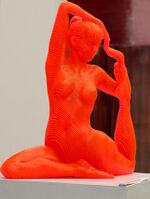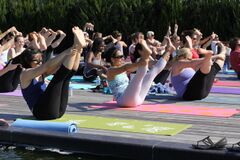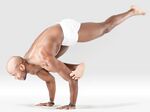Unsolved:Yoga as exercise
Yoga as exercise is a modern exercise practice influenced by hatha yoga. It involves holding stretches as a kind of low-impact physical exercise, and is often used for therapeutic purposes.[1] Yoga in this sense often occurs in a class and may involve meditation, imagery, breath work and music.[2][3]
Background and overview
Yoga has roots in India. The foundational text for yoga is the Yoga Sutras of Patanjali. Yoga came to the attention of the western public in the mid 19th century along with other topics of Hindu philosophy. The first Hindu teacher to actively advocate and disseminate aspects of yoga to a western audience was Swami Vivekananda, who toured Europe and the United States in the 1890s.[4][5]
Nearly all types of hatha yoga practices include asana, pranayama and savasana.[6] The physical asanas of hatha yoga have a tradition that goes back to at least the 15th century, but they were not widely practiced in India prior to the early 20th century.
A hatha "yoga boom" occurred in the 1980s, as unconnected to a religious denomination.[4] Since then, hatha yoga has been used as a supplementary exercise practice.[7]
The more classical approaches of hatha yoga, such as iyengar yoga, move at a more deliberate pace, emphasize proper alignment and execution and hold asanas for a longer time. They aim to gradually improve flexibility, balance, and strength. Other approaches, such as Ashtanga or power yoga, shift between asanas quickly and energetically. Contemporary approaches to yoga invite students to become their own authority in yoga practice by offering principle-based approaches to yoga that can be applied to any form.
Research
Much of the research on hatha yoga has been in the form of preliminary studies or clinical trials of low methodological quality, including small sample sizes, inadequate blinding, lack of randomization, and high risk of bias.[8][9] Hatha yoga does not have specific standardization of its practice.
Mental health
A 2010 literature review stated, "although the results from these trials are encouraging, they should be viewed as very preliminary because the trials, as a group, suffered from substantial methodological limitations."[10] A 2015 systematic review on the effect of yoga on mood and the brain concluded that "yoga is associated with better regulation of the sympathetic nervous system and hypothalamic-pituitary-adrenal system, as well as a decrease in depressive and anxious symptoms in a range of populations."[11] The same review recommended more methodological rigor be applied to future clinical trials.
One review found little evidence that yoga helps people with dementia perform their daily activities,[12] while another showed there were no effects on attention deficit hyperactivity disorder.[8] There was weak evidence supporting yoga as an alternative treatment for insomnia, with no evidence that yoga was better than general relaxation.[13]
Physical health
Only weak evidence was found to support the use of hatha yoga as a complementary therapy for rheumatic diseases, with no evidence of its safety.[14] Although one study found a small effect of yoga to lower high blood pressure, overall this evidence was too weak for any recommendation to be made, and provided no information about safety.[15] There was no evidence of benefit in treatment of epilepsy or menopause-related symptoms.[16][17] Practice of yoga had no effect on the underlying mechanisms of cancer.[18]
Safety
Although relatively safe, yoga is not risk free. Sensible precautions can usefully be taken – for example beginners should avoid advanced moves, yoga should not be combined with psychoactive drug use, and competitive yoga should be avoided.[19]
A small percentage of yoga practitioners each year suffer physical injuries analogous to sports injuries.[20] The practice of yoga has been cited as a cause of hyperextension or rotation of the neck, which may be a precipitating factor in cervical artery dissection.[21]
See also
- Exercise is Medicine
- International Journal of Yoga
- Neurobiological effects of physical exercise
- Yoga foot drop
References
- ↑ Syman, Stefanie (2010). The Subtle Body: The Story of Yoga in America. Macmillan. pp. 268–273.
- ↑ Feuerstein, Georg (2006). ""Yogic Meditation"". in Jonathan Shear. The Experience of Meditation. St. Paul, Minnesota: Paragon House. p. 90. "While not every branch or school of yoga includes meditation in its technical repertoire, most do."
- ↑ Editors, of Yoga Journal (2010). "Which Yoga is Right for you?". Yoga Journal: 80–85. http://www.yogajournal.com/basics/2353.
- ↑ 4.0 4.1 Shaw, Eric. 35 mOMents, Yoga Journal, 2010-09.
- ↑ Goldberg, Philip (2010). American Veda—How Indian Spirituality Changed the West. New York: Crown/Random House. p. 79. ISBN 978-0-385-52134-5.
- ↑ Forbes Bo. "Yoga Therapy in Practice: Using Integrative Yoga Therapeutics in the Treatment of Comorbid Anxiety and Depression". International Journal of Yoga 2008: 87.
- ↑ Barnes, P.; Powell-Griner, E.; McFann, K.; Nahin, R. CDC Advance Data Report #343. Complementary and Alternative Medicine Use Among Adults: United States, 2002
- ↑ 8.0 8.1 Krisanaprakornkit, T.; Ngamjarus, C.; Witoonchart, C.; Piyavhatkul, N. (2010). "Meditation therapies for attention-deficit/hyperactivity disorder (ADHD)". Cochrane Database of Systematic Reviews (6): CD006507. doi:10.1002/14651858.CD006507.pub2. PMID 20556767.
- ↑ Uebelacker, L. A.; Epstein-Lubow, G.; Gaudiano, B. A.; Tremont, G.; Battle, C. L.; Miller, I. W. (2010). "Hatha yoga for depression: critical review of the evidence for efficacy, plausible mechanisms of action, and directions for future research". Journal of Psychiatric Practice 16 (1): 22–33. doi:10.1097/01.pra.0000367775.88388.96. PMID 20098228.
- ↑ "Hatha yoga for depression: critical review of the evidence for efficacy, plausible mechanisms of action, and directions for future research". J Psychiatr Pract 16 (1): 22–33. January 2010. doi:10.1097/01.pra.0000367775.88388.96. PMID 20098228.
- ↑ Pascoe, Michaela C.; Bauer, Isabelle E. (1 September 2015). "A systematic review of randomised control trials on the effects of yoga on stress measures and mood". Journal of Psychiatric Research 68: 270–282. doi:10.1016/j.jpsychires.2015.07.013. ISSN 1879-1379. PMID 26228429.
- ↑ Forbes, Dorothy; Forbes, Scott C.; Blake, Catherine M.; Thiessen, Emily J.; Forbes, Sean (15 April 2015). "Exercise programs for people with dementia". The Cochrane Database of Systematic Reviews (4): CD006489. doi:10.1002/14651858.CD006489.pub4. PMID 25874613. http://cochranelibrary-wiley.com/doi/10.1002/14651858.CD006489.pub4/full.
- ↑ Sateia MJ, Buysse D, ed (2010). "Other Nonpharmacological Treatments of Insomnia" (in en). Insomnia: Diagnosis and Treatment. CRC Press. pp. 291. ISBN 9781420080803. https://books.google.com/books?id=r43LBQAAQBAJ&pg=PA291.
- ↑ "Yoga for rheumatic diseases: a systematic review". Rheumatology (Oxford) 52 (11): 2025–30. November 2013. doi:10.1093/rheumatology/ket264. PMID 23934220.
- ↑ "Yoga for essential hypertension: a systematic review". PLoS ONE 8 (10): e76357. 2013. doi:10.1371/journal.pone.0076357. PMID 24124549.
- ↑ Panebianco, Mariangela; Sridharan, Kalpana; Ramaratnam, Sridharan (2 May 2015). "Yoga for epilepsy". The Cochrane Database of Systematic Reviews (5): CD001524. doi:10.1002/14651858.CD001524.pub2. ISSN 1469-493X. PMID 25934967.
- ↑ Lee, M. S.; Kim, J. I.; Ha, J. Y.; Boddy, K.; Ernst, E. (2009). "Yoga for menopausal symptoms: a systematic review". Menopause 16 (3): 602–608. doi:10.1097/gme.0b013e31818ffe39. PMID 19169169.
- ↑ "Yoga". American Cancer Society. 1 November 2008. http://www.cancer.org/treatment/treatmentsandsideeffects/complementaryandalternativemedicine/mindbodyandspirit/yoga. Retrieved 1 April 2014.
- ↑ "Adverse events associated with yoga: a systematic review of published case reports and case series". PLoS ONE 8 (10): e75515. 2013. doi:10.1371/journal.pone.0075515. PMID 24146758.
- ↑ "Yoga in Australia: Results of a national survey". Int J Yoga 5 (2): 92–101. July 2012. doi:10.4103/0973-6131.98217. PMID 22869991.
- ↑ "Environmental factors and cervical artery dissection". Frontiers of Neurology and Neuroscience 20: 44–53. 2005. doi:10.1159/000088134. PMID 17290110.





